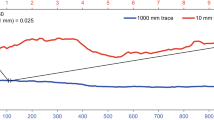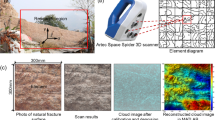Abstract
This work analyses the statistical link between the number of fractures counted by the geologist on fixed-size samples and the crushed length, namely the part of the sample that is crushed, a characteristic of the rock strength which must also be considered. For each sample, the fractures are classified according to their angle with the sample axis and it becomes possible to calculate a new attribute introduced in this paper, the “directional concentration”, a measurement of the dispersion of the fractures in the angular domain. This attribute explains the statistical link between fracturing and crushing, which leads to their correlation analyzed as a non-stationary regionalized variable. It then becomes possible to define spatial domains where, locally, the fractures are more or less numerous than expected based on a regionalized regression model. Two data sets were studied; the results were analyzed and interpreted by geotechnicians.
















Similar content being viewed by others
References
Barton N, Lien R, Lunde J (1974) Engineering classification of rock mass for the design of tunnel support (NGI publication 106, Oslo). Rock Mech 6(4):189–236
Rivoirard J (1994) Introduction to disjunctive kriging and non-linear geostatisics. Oxford University Press, Oxford
Séguret SA (2013) Analysis and estimation of multi-unit deposits: application to a porphyry copper deposit. Math Geosci. doi:10.1007/s11004-013-9475-0
Séguret SA, Guajardo C, Freire R (2014) Geostatistical evaluation of fracture frequency and crushing. In: Proceedings of caving 2014—third international symposium on block and sublevel caving, Santiago
Terzaghi RD (1965) Sources of error in joint surveys. Géotechnique 15(3):287–304
Acknowledgments
This work was financed by the French government and Codelco, Chile, and the author would like to thank this company for its strong support in the implementation of good geostatistical practices along the copper business value chain. Warm thanks to the geotechnical team of Chuqui and R&T, and especially Cristian Guajardo Moreno and Claudio Rojas Diaz without whom nothing would have been possible. Warm thanks to the Project Division at Santiago and especially Ramon Freire Rivera and Sergio Fuentes Sepulveda. The quality of this paper has been greatly improved by two anonymous reviewers, Jacques Rivoirard, a professional translator, and Zeus himself, many thanks to them.
Author information
Authors and Affiliations
Corresponding author
Appendices
Appendix 1: Fracture Counting
1.1 Angular Classes
There are three angular classes: [0\(^\circ \), 30\(^\circ \)], [30\(^\circ \), 60\(^\circ \)], and [60\(^\circ \), 90\(^\circ \)]. Normally, a direction in three dimensions is defined by the vector of the azimuth and the dip, but the only measurement at our disposal is \(\theta \), the angle between the sample axis and the fracture. In Fig. 17a, both fractures belong to the same [0, 30\(^\circ \)] set because no orientation is given to the sample axis and the smaller angle is taken.
a Example of a sample with two fractures. As no orientation is given to the sample, both fractures are included in the same class [0\(^\circ \), 30\(^\circ \)], b angular tolerance for the three directional classes. For classes [0\(^\circ \), 30\(^\circ \)] and [60\(^\circ \), 90\(^\circ \)] the maximum angle between two fractures is 60\(^\circ \) while in class [30\(^\circ \), 90\(^\circ \)], fractures can be perpendicular
The possible directions included in each class are cones represented by a cross-section in Fig. 17b. The classes are not equivalent: [0\(^\circ \), 30\(^\circ \)] and [60\(^\circ \), 90\(^\circ \)] classes may contain fractures that have an angle of up to 60\(^\circ \) maximum while the class [30\(^\circ \), 60\(^\circ \)] may contain perpendicular fractures. This affects the interpretation of the directional concentration when it is close to one because this result does not necessarily mean that the fractures at a given point are all parallel; some of them can be perpendicular. This situation must not occur often, otherwise the strong link between crushing and fracturing is not observable. The impact on the Terzaghi correction (see following) is probably more important because the correction factor is not the same for two perpendicular fractures and some artifacts will result from such errors.
1.2 Terzaghi Correction
Fracture counting is subject to a bias, which depends on the angle \(\theta \) that the fracture has with the sample direction. While this angle tends to zero (sample axis parallel to the fractures), the counting tends to under evaluate the number of fractures. Let us consider a particular domain of the deposit. The fractures can be classified into subsets according to their directions (Fig. 18a). Regarding the counting bias, it is equivalent to fixing the sample axis and considering the different fractures that are intersected, or fixing one fracture direction and considering different sampling directions (Fig. 18b).
If the sample length is L and its angle to the fracture direction is 90\(^\circ \), the length of an equivalent sample having \(\theta ^\circ \) must be equal to
to obtain the same number of fractures.
To make FF independent from the sample direction, the number of fracture \(N_{\mathrm{tot}}(x)\) must be corrected into \(N_{\mathrm{tot}\_\mathrm{corrected}}(x)\) so that
For a given angle \(\theta ,\) the number of fractures is multiplied by\(\frac{L^\prime }{L}=\frac{1}{\sin \theta }\). This is the Terzaghi correction (Terzaghi 1965), which is used in this paper. For each of the three angular classes, the correction is applied to the middle of the class and the coefficients are 3.86, 1.414, and 1.035 for, respectively, [0\(^\circ \), 30\(^\circ \)], [30\(^\circ \), 60\(^\circ \)], and [60\(^\circ \), 90\(^\circ \)]. This correction does not really account for the previously mentioned angular classes tolerance.
Appendix 2: Directional Variance and Equal Distribution
1.1 Directional Variance and Equal Distribution
Suppose that, for each location x, the \(N_{\mathrm{tot}} (\text {x})\) fractures are equally distributed over \(n_{\mathrm{dir}} (x)\le n_\theta \) directions. At this stage, it is not useful to randomize \(n_{\mathrm{dir}} (x)\) considered as a spatial scalar. Then, for each location x and each angle\(\theta \), \(N(\theta ,\text {x})\) is constant and equal to
and thus the directional variance develops
Directional concentration as defined by (16) when the fractures are part of a number of fractures \(n_\theta \) which is lower than or equal to \(n_{\mathrm{dir}} \), the total number of directional classes inside which the fractures are classified
and finally
a formula which obviously requires \(n_{\mathrm{dir}} (x)>0\).
The behavior of Eq. (16) as a function of \(n_{\mathrm{dir}} \) is hyperbolic (Fig. 19). Its minimum is at \(n_{\mathrm{dir}} =n_\theta \) where \(\sigma _{\theta ,\mathrm{equally}}^2 (n_{\mathrm{dir}} )=0\), a situation of a full directional isotropy, all the fractures are equally distributed over the \(n_\theta \) directions. Its maximum is at \(n_{\mathrm{dir}} =1\) where \(\sigma _{\theta ,\mathrm{equally}}^2 (n_{\mathrm{dir}} )=\sigma _{\theta ,\max }^2 \), with
All the fractures lie along one direction, situation of a full directional anisotropy. As Eq. (17) does not depend on\(n_{\mathrm{dir}} \), it represents the maximum of \(\sigma _\theta ^2 (x)\) in any case.
Link with Barton Q Classification and Joint Sets
A parameter used in the geotechnical classification, named “Barton Q” (Barton et al. 1974), consists of counting the main directions of the fractures, producing an attribute called “Number of Joint Sets” (\(J_{n})\). For example, in Fig. 20, there are \(N_{\mathrm{tot}} (x)=4\) fractures classified into two pairs each with very similar directions and \(J_{n}=2\).
This attribute aims at quantifying the directional concentration of the fractures. It is not directly connected to \(R_\theta ^2 (x)\) because it is deduced from fractures that can belong to the same angular sets ([0, 30\(^\circ \)] in the figure). The case of Fig. 20 gives \(n_{\mathrm{dir}} (x)=1\) and \(\sigma _\theta ^2 (n_{\mathrm{dir}} )=\sigma _{\theta ,\max }^2 \) so \(R_\theta ^2 (x)=1\). The full directional anisotropy seems reached when considering \(R_\theta ^2 (x)\) while it would be the case only if \(J_{n}=1\). Here the price is paid for a crude angular classification which does not consider sample axis orientation. \(J_{n}\) gives a detail that is not handled by \(R_\theta ^2 (x)\). Suppose that the number of angular classes is multiplied by 2 and \(n_\theta =6\): [0\(^\circ \), 30\(^\circ \)], [30\(^\circ \), 60\(^\circ \)], [60\(^\circ \), 90\(^\circ \)], [90\(^\circ \), 120\(^\circ \)], [120\(^\circ \), 150\(^\circ \)], [150\(^\circ \), 180\(^\circ \)]. The calculation gives\(R_\theta ^2 (x)=\frac{2}{3}\), a value still closer to the anisotropy than to the isotropy, but no longer identical to the extreme case. This better angular resolution makes possible the distinction and \(R_\theta ^2 \) becomes at least as informative as \(J_{n}\).
A possible way to link \(J_{n}(x)\) and \(R_\theta ^2 (x)\) in a more formal way is to assume, as previously, that the \(N_{\mathrm{tot}} (x)\) fractures are uniformly distributed over \(n_{\mathrm{dir}} (x)\le n_\theta \) directions. Then each of the \(n_{\mathrm{dir}} (x)\) directions contains \(\frac{N_{\mathrm{tot}} (x)}{n_{\mathrm{dir}} (x)}\) fractures and if this ratio is an integer at least equal to 2, then\(J_n (x)=n_{\mathrm{dir}} (x)\).
Rights and permissions
About this article
Cite this article
Séguret, S.A. Fracturing, Crushing, and Directional Concentration. Math Geosci 48, 663–685 (2016). https://doi.org/10.1007/s11004-015-9624-8
Received:
Accepted:
Published:
Issue Date:
DOI: https://doi.org/10.1007/s11004-015-9624-8








